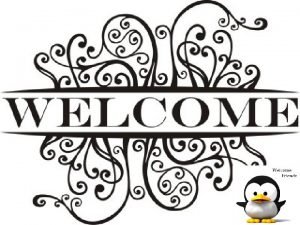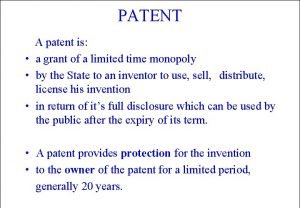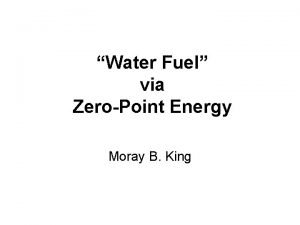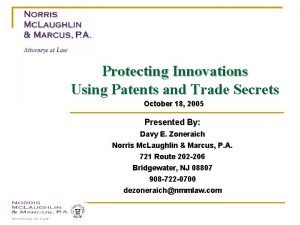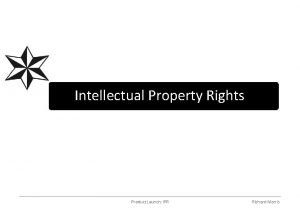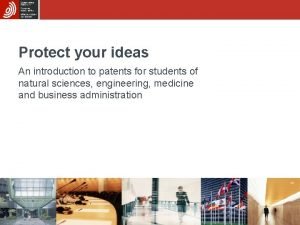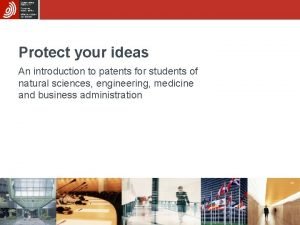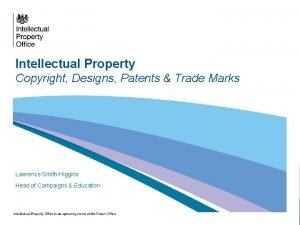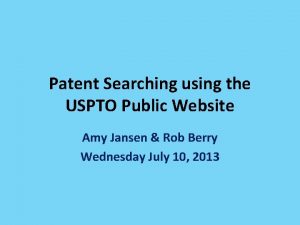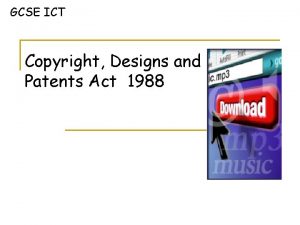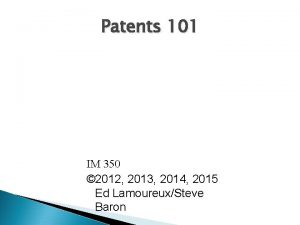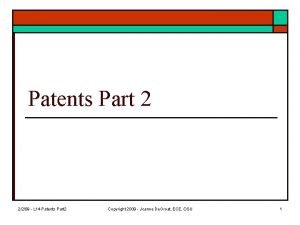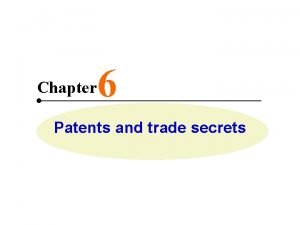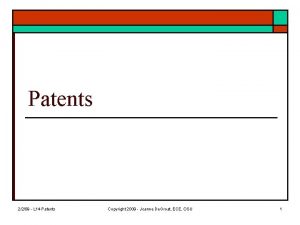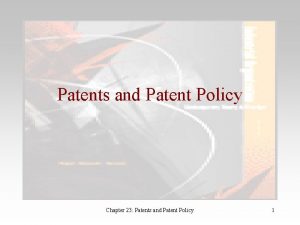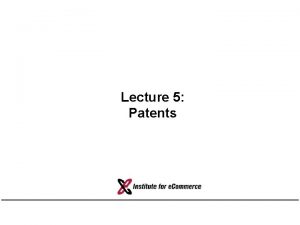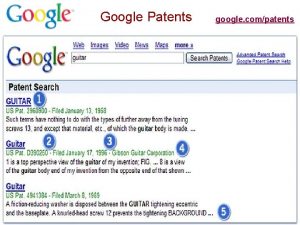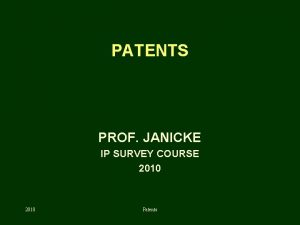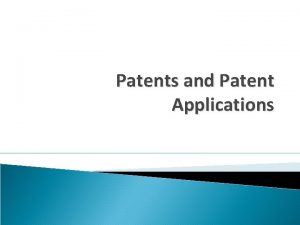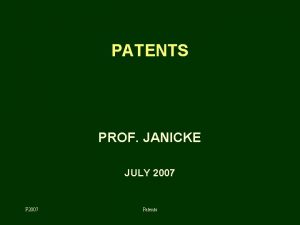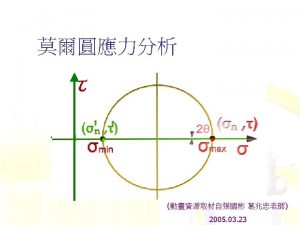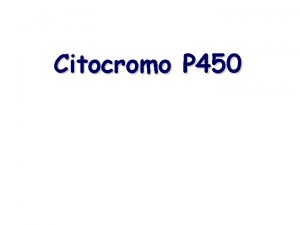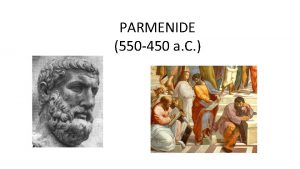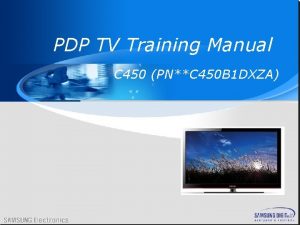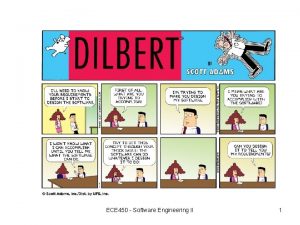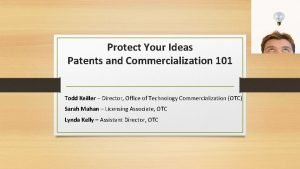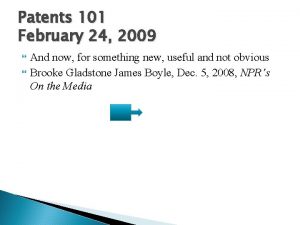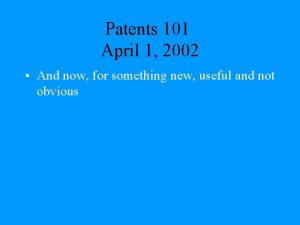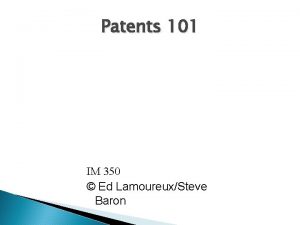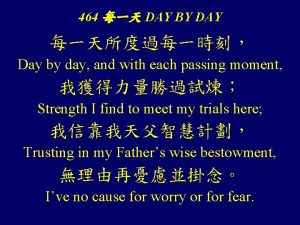Patents 101 IM 450 Day 7 2012 2013

























- Slides: 25

Patents 101 IM 450 Day 7 © 2012, 2013, 2014, 2015, 2017 Ed Lamoureux/Steve Baron

� And now, for something new, useful and not obvious ◦ 5 of the most absurd patents in the ◦ Our patent system is broken beyond repair (Jay Walker, Priceline founder and CEO of a new nofault licensing outfit) ◦ Patent systems to protect patents are crucial, ours isn’t THAT bad, and we should fix what we can. (FTC commissioner Maureen K. Ohlhausen)

Patent Complexities � Special court: Court of Appeals for the Federal Circuit Court � Special lawyers and certification � Large DC bureaucracy, though many claim that the principle problem is that the office is overwhelmed. ◦ Over 629, 000 filings a year now compared to 300, 00 in 2000. �https: //www. uspto. gov/web/offices/ac/ido/oeip/taf/us_stat. htm ◦ Over 9, 000 examiners in 2014 �https: //patentlyo. com/patent/2014/11/usptos-swelling-examiner. html ◦ Approximately 10, 000 examiners would provide the personhours needed to process 600, 000 filings a year. ◦ So although the office has closed the gap and slowed the growth, the massive backlog from 2014 (and earlier) remains a challenge. Applications can take 3 years to complete.

Patent Complexities ◦ During the “change-over” to digital, the office probably made loads of mistakes, esp. by giving out patents on processes that were not yet understood (many of these were formative digital technologies). ◦ Many of those patents have been litigated over and over (continuing today) ◦ EFF’s Patent Busting Project

What is a Patent? �A U. S. patent for an invention is the grant of a property right to the inventor(s), issued by the U. S. Patent and Trademark Office. The right conferred by the patent grant is, in the language of the statute and of the grant itself, “the right to exclude others from making, using, offering for sale, or selling” the invention in the United States or “importing” the invention into the United States. To get a U. S. patent, an application must be filed in the U. S. Patent and Trademark Office.

What Law Governs Patents? �The first patent law was enacted in 1790. The patent laws underwent a general revision that was enacted July 19, 1952, and that came into effect January 1, 1953. It is codified in Title 35, United States Code. Additionally, on November 29, 1999, Congress enacted the American Inventors Protection Act of 1999 (AIPA), further revised the patent laws. The America Invents revision in 2011 became effective by 2013.

What Can Be Patented? � Any person who “invents or discovers any new and useful process, machine, manufacture, or composition of matter, or any new and useful improvement thereof, may obtain a patent, ” subject to the conditions and requirements of the law. May include: ◦ Improvements to known technologies ◦ New combinations of known technologies ◦ New uses of known technologies � These classes of subject matter taken together include practically everything that is made by man and the processes for making the products.

What Cannot Be Patented? � Inventions useful solely in the utilization of special nuclear material or atomic energy for atomic weapons. � The laws of nature, physical phenomena, and abstract ideas are not patentable subject matter. � A mere idea or suggestion.

Conditions For Obtaining A Patent Novelty �The patent law specifies that the subject matter must be “useful. ” ◦ the subject matter has a useful purpose and also includes operability ◦ E. g. , a machine which will not operate to perform the intended purpose would not be called useful, and therefore would not be granted a patent. �In order for an invention to be patentable, it must be new as defined in the patent law.

Conditions For Obtaining A Patent Novelty �An invention cannot be patented if: �“(a) the invention was known or used by others in this country, or patented or described in a printed publication in this or a foreign country, before the invention thereof by the applicant for patent, ” or � “(b) the invention was patented or described in a printed publication in this or a foreign country or in public use or on sale in this country more than one year prior to the application for patent in the United States. . . ”

Conditions For Obtaining A Patent - Novelty If the inventor describes the invention in a printed publication or uses the invention publicly, or places it on sale, he/she must apply for a patent before one year has gone by, or lose the patent rights. -under “first to invent, ” this meant a year during which the inventor could actively discuss the invention with experts. -under “first to file, ” this appears to mean that the office MIGHT consider a claim, within a year, even though the inventor went public and has not yet filed. But if someone else files: trouble. The inventor must file on the date of public use or disclosure, however, in order to preserve patent rights in many foreign countries.

Conditions For Obtaining A Patent - Non-Obviousness The subject matter sought to be patented must be sufficiently different from what has been used or described before that it may be said to be nonobvious to a person having ordinary skill in the area of technology related to the invention. For example, the substitution of one color for another, or changes in size, are ordinarily not patentable.

Types of Patents � Utility patents may be granted to anyone who invents or discovers any new and useful process, machine, article of manufacture, or compositions of matters, or any new useful improvement thereof. � Design patents may be granted to anyone who invents a new, original, and ornamental design for an article of manufacture. (THESE ARE NOT GRAPHIC DESIGNS, FABRIC DESIGNS, SOFTWARE DESIGNS, etc. � Plant patents may be granted to anyone who invents or discovers and asexually reproduces any distinct and new variety of plant.

Types of Patents �Business methods/process (software patents are usually of this type) ◦ Originally allowed like any other invention. ◦ [Then] (roughly, 1905 -1998 --before State Street v. Signature) disallowed. �[Then] allowed IF the innovation advanced the technological arts. �That special requirement was struck in 2005. ◦ Now business methods are treated as any other type of innovation. ◦ Bilski, at the Supreme Court, retained: process patents

◦ With lots of “how to use technology” stuff, it’s tough to determine whether the innovation is a product or a process. �Early digital technology, esp. internet activities, got through as products when they were processes AND �A lot of these turned out to be bad filings and approvals BUT �Now we’re stuck with trying to work them out. �For example: Gibson and Guitar Hero �“Gibson says Guitar Hero too closely matches a musical virtual-reality patent from 1999, and Activision should not be able to sell the game until it receives a license under the patent. ”

How Long and Where is a Patent Protected? Generally, the term of a new patent is 20 years from the date on which the application for the patent was filed in the United States or, in special cases, from the date an earlier related application was filed, subject to the payment of maintenance fees. U. S. patent grants are effective only within the United States, U. S. territories, and U. S. possessions. Under certain circumstances, patent term extensions or adjustments may be available.

Patent Process � Overview � One should not publish/demonstrate/sell/offer to sell publically until after making application (for US only, there’s a one year grace period, but not oversees, or here, after the new bill goes into place). ◦ Although there are debates over how and how well this grace period work under “first to file. ” � First to invent used to win in US. � First to file wins elsewhere. � First to file here since March 13, 2013.

Patent reform: Leahy-Smith America Invents Act � The law harmonized the American patent process with the rest of the world: First to file � A fast track option for Patent Processing within 12 Months: Instead of an average wait time of almost three years, the Patent and Trademark Office will be able to offer startups growing companies an opportunity to have important patents reviewed in one-third the time – with a new fast track option that has a guaranteed 12 -month turnaround. Patent ownership is a critical factor venture capital companies consider when investing in entrepreneurs hoping to grow their business.

� Reducing the current patent backlog: , the patent backlog was reduced in the first couple years after the act, from over 750, 000 patent applications to 680, 000, despite a 4% increase in filings. The additional resources provided in the law will allow the Patent and Trademark Office to continue to combat the backlog of nearly 700, 000 patent applications and will significantly reduce wait times. � Reducing litigation: Review process for approved patents. � Increasing office budget: enable price increases. ◦ Could hurt smaller tech firms: http: //www. forbes. com/sites/ciocentral/2011/09 /20/new-patent-law-means-trouble-for-techentrepreneurs/

The timeline Source: http: //parts. mit. edu/igem 07/index. php/Kristin_Fu

Penalties �Court awarded damages, issued to the patent owner ◦ Amount could be set by jury or judge. ◦ Requires the infringer to pay monetary damages of a variety of types. �Compensation for wrongful use. �royalty rate: what would the cost of licensing have been? �Under some circumstances, this amount can be “factored” (tripled) for willful infringement �Interest on the damages from the date of first infringement �Court costs (but generally not attorney’s fees)

Penalties � Injunction, perhaps stayed (or invoked) during appeal, permanent or otherwise, to stop further infringement.

Patent Tolls � What is a patent troll? � Rise of the patent trolls � Fighting back, trying to slow the trolls: ◦ Patent. Freedom ◦ Linux Defenders

Trolls are a symptom of deeper problems. . . � � not the cause of the patent system’s problems. If we had a well-designed patent system in which only high-quality patents were issued, it would be much harder for patent trolls to engage. . . abusive behaviors. . . The reason patent trolling is so profitable is that over the last quarter century the courts have expanded patenting into new areas like software and business methods, and dramatically lowered the bar for receiving a patent. As a result, patents that would have been rejected 30 years ago (like this ridiculous patent on removing white space from database entries, which IBM received earlier this month) are now routinely approved by the Patent Office. As a result, patent trolls are able to buy up low-quality patents by the truckload. Timothy Lee, Cato Institute, 2009

Plus: what’s really a troll? � Patent Trolls & Investment Portfolios. . . ◦ When is a troll not a troll at all? �There are many non-practicing entities (like universities) that are not trolls at all �And most corporations have lots of nonpracticing patents in their portfolios � When is “investing in technologies” being a troll, and when is it just sound investment strategy? [it’s like a duck, I know one when I see one]
 Day 1 day 2 day 3 day 4
Day 1 day 2 day 3 day 4 997 x 450 + 3 x 450 bernilai sama dengan
997 x 450 + 3 x 450 bernilai sama dengan Day 1 day 2 day 817
Day 1 day 2 day 817 Patents are granted for a new
Patents are granted for a new Stanley meyer patents pdf
Stanley meyer patents pdf Types of patents
Types of patents Patents
Patents Advantage of patent
Advantage of patent Advantages and disadvantages of patents
Advantages and disadvantages of patents What is the copyright designs and patents act 1988
What is the copyright designs and patents act 1988 Different types of patents
Different types of patents Copyright designs and patents act 1988
Copyright designs and patents act 1988 What is easter about?
What is easter about? Observation of plant growth day by day
Observation of plant growth day by day Day to day maintenance
Day to day maintenance Haiku and
Haiku and Dayone dayone ss2
Dayone dayone ss2 Growing day by day
Growing day by day I live for jesus day after day
I live for jesus day after day Physical science chapter 6 review answers
Physical science chapter 6 review answers Observation of seed germination day by day
Observation of seed germination day by day One day casting crowns
One day casting crowns I don't know tomorrow
I don't know tomorrow Seed germination conclusion
Seed germination conclusion William beanes elementary
William beanes elementary Day one day one noodle ss2
Day one day one noodle ss2

